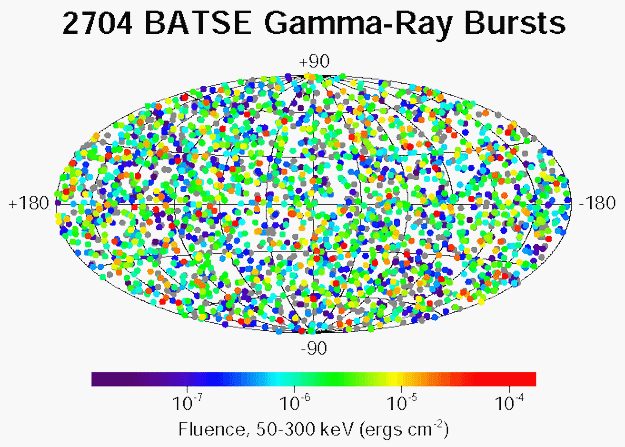Gamma Ray Burstsby Mark WyattApril 10, 2008Gamma Ray BurstsGamma ray bursts (GRBs) are distributed isotropically throughout our view. They show-up, roughly one day randomly in the sky. The following figure shows 2704 GRBs detected by the BATSE satellite.
Observations indicate they occur isotropically, so there are at least two possibilities: 1. They occur relatively close to the earth and/or our galaxy; In this case, their energy levels may be resonable, but then redshifts, which are high (indicating great distances) in many cases, would not match with theory. 2. They occur at very great (cosmological) distances; Under this circumstance, redshifts make sense as a distance indicator, but energies would have to be astronomical. In either case, they are still isotropic- i.e., they occur spherically symetrically around us. Current science contends that these bursts occur at very great (cosmlogical) distances, thus giving the isotropic appearance. The problem is that the energy required for us to see them if they originate at these distances is unbelievably immense. In order to support the existnece of GRB at these distances and thus energies, scientists have to hypothesize that GRBs are produced by the collapse of stars into black holes in ultra-relativistic events. The other possibilty is that they are not at cosmological distances, and they do not produce immense and unbelievable amounts of energy. It is possible that we are in the center of this distribution of GRBs, and thus in a central location. On March 21, 2008, the Swift satellite captured a GRB named "GRB-080319B" touted as the brightest object ever seen. It is described as It was, at peak, approximately equivalent to a few hundred million billion suns! later, ... brighter than the light from all of the stars in five million Milky Way Galaxies... SWIFT images (the satelliet that detected the GRB) show this bright explosion (x-ray telescope left, optical/UV right).
All this "few hundred million billion suns" and "five million Milky Way Galaxies" are premised on the assumption that redshifts translate to distance. Halton Arp and others have developed evidence that casts question on this redshift interpretation. This evidence is based on photographs of neutron stars (with very high redshifts indicating cosmological distances) positioned inside and often connected to ordinary galaxies (with low redshift values, and thus not at cosmological distances). The Swift satellite detected the GRB, turned, and photographed the area the object was detected in. From the spectrum of the photograph, redshift is determined. From the redshift, the distance is calculated using the Hubble formula. In order to support the huge energies this GRB produced, scientists require that it was caused by an ultra-relativistic collapse of a huge star, and that GRBs create jets of light (i.e., it is not an isotropic flash). By modeling the GRB as emmitting jets, the tiotal amount of energy necassary to account for the distnces is much less. It also implies we may be missing many of the GRBs, since, only objects in the cone of the jet will detect it. The following video is an animations illustrating what such a collapse and resulting jet may look like. If in fact redshift does not translate into distance (either for GRBs, or in general), and the GRB is much closer, then the amount of energy actually released could be far far less. |

